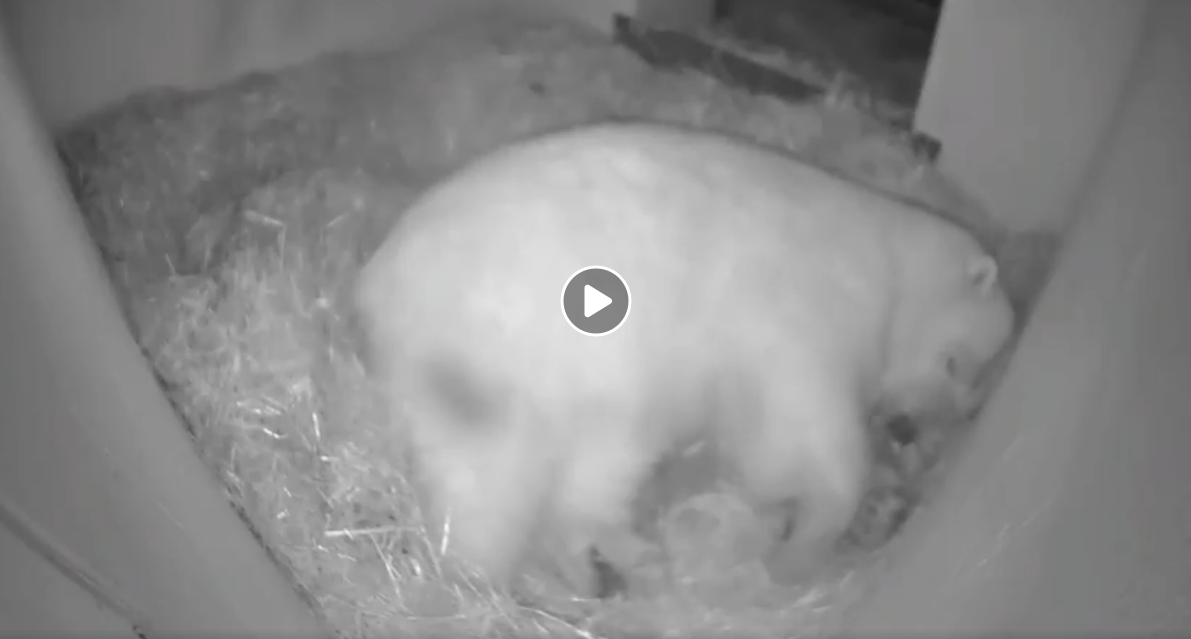Columbus Zoo giving thanks for new polar bear cub

The Columbus Zoo and Aquarium has a lot to be thankful for with its brand new, healthy polar bear cub!
The cub was born on Thanksgiving Day, to mother, Aurora, and father, Lee. The Animal Care team notes that Aurora is being an attentive mother to her new cub, who has been observed nursing. As Aurora continues to care for her cub, she and her little one will remain in their private denning area behind the scenes until spring.
Oh Baby!! The Columbus Zoo and Aquarium is truly thankful to welcome a new polar bear cub born on Thanksgiving Day, November 28, at 12:43 a.m. to mother Aurora and father, Lee! The Animal Care team notes that Aurora is being an attentive mother to her new cub, who has been observed nursing. As Aurora continues to care for her cub, she and her little one will remain in their private denning area behind the scenes until spring.While Aurora is not new to motherhood, having given birth to Nora (Utah's Hogle Zoo) and twins Neva (The Maryland Zoo in Baltimore) and Nuniq (Henry Vilas Zoo), this is the first cub to be sired by male polar bear, Lee. Lee arrived at the Columbus Zoo from Denver Zoo on November 7, 2018. His move was recommended by The Association of Zoos and Aquariums’ (AZA) Species Survival Plan® (SSP), a cooperatively managed program designed to maximize the genetic diversity and increase the population sustainability of threatened and endangered species in human care. Both Aurora and her twin sister, Anana, have been denning for several weeks. The Animal Care team observed Aurora frequently resting in her den leading up to the cub’s birth, while Anana has shown more activity, indicating that she may not be preparing for a birth. Because there are no pregnancy tests for polar bears, the team will continue to monitor Anana’s activity as polar bears can give birth from November to early January. Polar bears have one of the lowest reproductive rates of any mammal due to delayed implantation, during which a fertilized egg does not implant in the uterus for several months to ensure the cub is born to the mother at the best time for survival. In 2008, the polar bear became the first species to be listed under the Endangered Species Act as threatened primarily due to climate change. Since 2008, the Zoo has contributed more than $250,000 to research benefiting polar bears in the Arctic. The Zoo is also designated as an Arctic Ambassador Center by Polar Bears International (PBI). At the Columbus Zoo, visitors are encouraged to do their part to save this amazing species by turning off lights when leaving a room, minimizing their use of heating and cooling units, and other ways to reduce energy consumption. For more information about this significant birth, visit: bit.ly/2OSF2ma
Posted by Columbus Zoo and Aquarium on Friday, November 29, 2019
In addition to this latest arrival, 13-year-old Aurora has previously given birth to three litters, consisting of three other surviving cubs. Her first cub, Nora, who now lives at Utah’s Hogle Zoo, was born on November 6, 2015 and hand-reared by Animal Care staff who needed to step in to care for her. On November 14, 2016, Aurora then gave birth to twins, female, Neva, and male, Nuniq, and provided them with excellent care. Neva now lives at The Maryland Zoo in Baltimore with her half-sister, Amelia Gray (who was born the same year to Anana), and Nuniq lives at the Henry Vilas Zoo in Madison, Wis.
Aurora’s cub born yesterday is the first to be sired by 20-year-old Lee, who arrived at the Columbus Zoo from Denver Zoo on November 7, 2018.
BROUGHT TO YOU BY
From mounted cameras, Aurora’s cub was observed being born at 12:43 a.m. The team has been monitoring Aurora and her twin sister, Anana, around the clock as they have both been denning for several weeks. Both females have given birth in the past, and Animal Care staff are very familiar with the bears’ behavior patterns. While Aurora was frequently resting in her den leading up to the cub’s birth, Anana has shown more activity, indicating that she may not be preparing for a birth.
“The birth of this polar bear cub is extremely exciting, of course, but the work of our team isn’t over as the survival rate for a delicate cub during its first few weeks is low based on a variety of factors,” said Columbus Zoo and Aquarium President/CEO Tom Stalf. “I am also extremely proud of our Animal Care team, who continually show their expertise and dedication as they work day and night to provide the animals with top quality care.”
BROUGHT TO YOU BY



